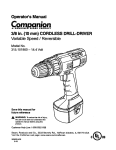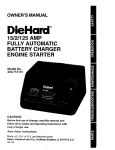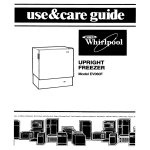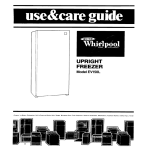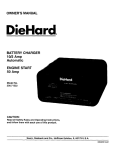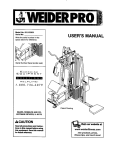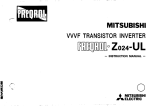Download DieHard 200.71231 Owner`s manual
Transcript
OWNER'S MANUAL DieHard, BATTERY CHARGER 50/15/2 Amp Manual ENGINE STARTER With Battery Tester 225/125 Amp Model No. 200.71231 CAUTION: Read all Safety Rules and Operating Instructions, and follow them with each use of this product. Sears, Roebuck and Co., Hoffman Estates, IL 60179 U.S.A. 0099000313-402 Table Of Contents Warranty .................................................................... 1 Using Your Battery Charger ..................................... 8 Important Safety Instructions ................................. 2 Setting the controls .............................................. 8 Parts .......................................................................... 3 Charging your battery ........................................ 10 Before Using Your Battery Charger ........................ 4 Calculating charge times .................................... 12 Assembling your charger ..................................... 4 Using the engine start feature ............................ 13 Plugging it in ........................................................ 5 Using an extension cord ....................................... 6 Maintenance and care ....................................... Troubleshooting ..................................................... Preparing your battery to be charged .................. 7 Please read this Manual be_fore using your Battery Charger The DieHard model 71231 Manual Battery Charger/Engine Starter, offers a wide range of features to accommodate the needs for home or light commercial use. This manual will show you how to use your charger safely and effectively. Please read and follow these instructions and precautions carefully. For information about troubleshooting, call toll-free from anywhere in the U.S.A. 7 am to 4:30 pm CT Monday through Friday. 1-800-SEARS-64 (1-800-732-7764). For repair parts or the location of a Sears Parts and Repair Center call: 1-800-4-MY-HOME e (1-800-469-4663). Warranty FULL THREE-YEAR WARRANTY If, within three years from the date of purchase this battery charger fails due to a defect in material or workmanship, RETURN IT TO THE NEAREST SEARS STORE IN THE UNITED STATES, and Sears will repair or replace it, free of charge. This warranty gives you specific legal rights, and you may also have other rights which vary from state to state. Sears, Roebuck and Co., Dept 817WA, Hoffman Estates, IL 60179 13 14 Important Safety Instructions - SAVE THESE INSTRUCTIONS To reduce the risk of explosion, explcelve gamin, or Injury while using your battmy charger, follow the precautions listed below:. • Read all instructions and cautions printed on the battery charger, battery, and vehicle or equipment using battery. • Use charger only on lead-acid type rechargeable batteries, such as those used in cars, trucks, tractors, airplanes, vans, RV's, trolling motors, etc. This charger is not intended to supply power to a low voltage electrical system other than in an automotive application. • Do not disassemble Charger. Take it to a qualified service professional if service or repair is required. Incorrect assembly may result in fire or electrical shock. • To reduce risk of electrical shock, unplug the charger from the outlet before attempting any maintenance or cleaning. • Always charge battery in a well ventilated area. • Use only attachments recommended or sold by manufacturer. The use of attachments not recommended by the manufacturer may result in fire, electric shock, or injury. Help us help you Remember: • Place charger as far away from battery being charged as the charger cables will permit. • Never touch the battery clamps together when the charger is energized. • Do not expose charger to rain or snow. • Never operate charger if it has received a hard blow, been dropped, or otherwise damaged. Take it to a qualified professional for inspection and repair. • Never charge a frozen battery. If battery fluid (electrolyte) becomes frozen, bring battery into a warm area to thaw before you begin charging. • Never allow battery acid to drip on charger when reading specific gravity or filling battery. • Never set a battery on top of the charger. • Neverplace charger directly above battery being charged. The gases from the battery will corrode and damage the charger. • Never use charger for charging dry-cell batteries that are commonly used with home appliances. These batteries may burst and cause personal injury. Personal Safety Precautions For your own personal safety, please follow the following precautions: • Wear complete eye and clothing protection when working with lead-acid batteries. • Be sure that someone is within range of your voice to come to your aid if needed while you work with or are near a lead-acid battery. • Have plenty of fresh water and soap nearby for use in case battery acid contacts your eyes, skin, or clothing. If this happens, wash immediately with soap and water. Then get medical attention. • Avoid touching your eyes while working with a battery. Acid particles (corrosion) may get into your eyes. If this occurs, flush eyes immediately with running cold water for at least 10 minutes. Then immediately get medical attention. • Be sure to position the charger power cord to prevent it from being stepped on, tripped over, or damaged. • Never pull out the plug by the cord when unplugging the charger. Pulling on the cord may cause damage to the cord or the plug. • Do not operate the charger if it has a damaged power cord or plug. Have the cord replaced. • Remove all personal metal Items from your body, such as rings, bracelets, necklaces, and watches while working with a lead-acid battery. A battery can produce a short circuit current high enough to weld a ring (or the like) to metal, causing a severe bum. • Take care not to drop any metal tool or metal object onto the battery. This may spark or short circuit the battery or another electrical device that may cause an explosion. • Always operate your battery charger in an open, well ventilated area. • Never smoke or allow a spark or flame in the vicinity of the battery or engine. Batteries generate explosive gases. • Neutralize any acid spills thoroughly with baking soda before attempting to clean up. Parts This section shows an Illustration of your battery charger. Use It to become familiar with where all the parts ere located, and what they look like. Item 1. Deecrlptlon Handle Part Number 359900(_86 2. Negative (BLK) Cable w/clamp_ 3899000_91 3. Po6itive (RED) Cable w/clamps 3899000408 4. Power Cord 5. Cimuit Breaker Assembly 3999000065 6. Rectifier Assembly 2299001081 7, Transformer 8. Fan Motor 0099000063 9, _(_6125 93026533 Whesl 0O990OOO80 10. HubCap 5200(X)0(_8 11. AxJe 009900006O 12. Axle Mtg. Brackets 1199004366 13, MountingFoot 1199003352 14. Voitmetar 5399200013 15. Ammeter 5399100131 16. Rocker Switch 2 Position 0499000050 17. Timer 0099000094 18, Rotary Switch 0499000051 19. Rotary Switch Knob 0099(_(X)45 20. Timer Control Knob 0099000096 21. Owner's Manual 0099000313 Wiring Diagram NEG. BAT. CABLIE [] I AC _ 3 Before Using Your Battery Charger It is important to prepare your charger for use. This section will tell you how to assemble the charger, ground and connect the power cord, and prepare to charge a battery. Assembling your charger It is important to fully assemble your charger before use. Follow these instructions for easy assembly. PARTS: TOOLS NEEDED: Two 10-32 thread cutting screws 3/8" wrench (for mounting foot) Two 1/4-20 thread cutting screws 5/16 =wrench (for wheels) Two wheels Hammer One axle Phillips scrawddver Two axle caps Two axle brackets One handle One mounting foot To attach the axle assembly: 1. , Remove charger from packing materials and place upside down on a flat surface. Attach mounting foot and secure with the two 1/4-20 thread cutting screws. Hold axle upright on floor or work surface. Then, using a hammer, tap one of the plastic hubs onto the top end of the axle. Be sure to tap the hub on straight. Slide both wheels onto the axle with the hubs facing inward. A 4 continued on next page . Tap the other axle cap onto the opposite end of the axle and place the axle assembly onto the bottom of the charger. Place one end of the bracket into slot, then place the axle assembly under each bracket. Fasten the other side of the brackets using the two 10-32 screws provided. To attach the handle: Turn the charger right side up onto its foot and wheels. Remove the two top screws from each side of the charger and align with the screw holes on the handle. Attach the handle using the same screws. Plugging it in Your charger should be grounded to reduce the risk of electrical shock. Your charger is equipped with an electrical cord that has an equipment grounding conductor and a grounding plug designed to be used on a 120 volt circuit. The plug must be plugged into an outlet that has been properly installed and grounded in accordance with all local codes and ordinances. 5 ATEMPORARY adaptermay be used to connect the charger to a two-pole outlet if a propedy grounded outlet is not available. Use the adapter ONLY until a propedy grounded outlet can be installed by a qualified electrician. AL WARNING: nection Improper adapter can result in electrical con- shock. Before using an adapter as illustrated, be certain that the center screw of the outlet plate is grounded. The green colored grounding clip of the adapter must be attached by a metal screw to a properly grounded outlet. If unsure whether outlet is propedy grounded, contact a professional electrician. If necessary, replace the original outlet cover screw with a longer one that will secure the grounding clip to the outlet cover and make a ground connection to the grounded outlet. Using an extension cord The use of an extension cord is not recommended. If you must use an extension cord, please make sure that you follow these guidelines: • Make sure the pins on the plug of the extension cord are the same number, size, and shape as those of the plug on the charger, • Use only 3-conductor (grounded) extension cord when necessary. • Check-that the extension cord is properly wired and in good electrical condition. • Use the recommended minimum AWG (American Wire Gauge) to be sure that wire size is large enough for the rating of the charger. "AWG=Amerioan Wire Gauge Preparing your battery to be charged It is important that you read and follow these guidelines while you are preparing to charge your battery. • Make sure that you have a 12 volt or 6 volt lead-acid battery. Set the volt/amp selector switch to match the voltage rating of the battery to be charged. • Clean the battery terminals. Be careful to keep corrosion from getting in or around your eyes. • If you have a battery with removable call caps, if required, add distilled water to each call until the battery acid reaches the level indicated by the manufacturer. This will help purge excessive gases from the cells. Be careful not to overfill. If you have a sealed battery without cell caps, no action is necessary. Continue to the next step listed below. • Take time to read all battery manufacturer's specific precautions, such as removing or not removing cell caps while charging, and recommended rates of charge. • Wear safety glasses. See additional "Personal Safety Precautions" on page 2. • Be sure that the area around the battery is well ventilated while it is being charged. If ventilation is poor, gas can be manually blown away by using a piece of cardboard or other non-metallic material as a fan. • If it is necessary to remove the battery from the vehicle to charge it, always remove the grounded terminal from the battery first. A spark may be caused if all accessories in the vehicle are not completely turned off. NOTE: A marine battery installed in a boat must be removed and charged on shore. 7 Using Your Battery Charger To obtain the best results from your battery charger, you must know how to use it properly. This section tells how to set the controls and how to charge a battery in and out of the vehicle. Setting the controls All the controls for your charger are located on the front of the unit. Follow these instructions to obtain the accurate charge level for your battery. VOLT/AMP SELECTOR: The volt/amp selector switch allows you to select an amp charge rate and battery voltage type to match your charging needs. Read the following operating instructions for making the proper settings for charging a battery and using the engine start feature. TIMER: The timer is designed to allow your battery to be charged for a designated amount of time. To accurately charge your battery, you must know the size of the battery in ampere hours or reserve capacity in minutes, as well as the state of charge. Since this information is often not known, the timer limit is set at 2.25 hours. This will help prevent the battery from overcharging to a point where it can be damaged. If you do not know the charge state of your battery, it is best to start out with the timer set at one hour or less. HOLD FEATURE: This position overrides the timer, allowing the charger to continue charging for over 2.25 hours. This feature is most often used when the charging rate is 2 or 15 amps. Using this feature requires you to monitor the charging and to stop the charger when the battery is fully charged. Otherwise, charger will not stop and may cause damage to your battery. AMMETER: The ammeter indicates the measured amount of amperes being drawn by the battery. When you first start charging a battery, the reading will be high, with the needle around 50 or "START" when the selector is in the 50 amp charge position. As the battery becomes charged, the reading will decrease to 15 or 20 amps at full charge. This will be your indicator to stop charging. With the selector switch set to the 15 amp position, the meter needle should display 15 amps for a discharged battery and 7-8 amps when the battery is fully charged. If you are using the 2 amp charge rate, you may see little or no meter needle activity. 8 The "START" area of the ammeter indicates a high rate of current being drawn by the battery. For example, when cranking an engine, the needle will be at the far right side of the =START" area since the starter will be drawing up to 225 amps from the charger. ALTERNATOR/GENERATOR 1. 2. 3. 4. VOLTMETER: To obtain an accurate reading of your battery's voltage before you charge, use the voltmeter as follows: 1. Set the timer to the OFF position, put the voltage selector switch at 12 or 6 VOLT according to the battery you are testing, and then connect the charger as indicated in "Charging your battery in the vehicle" on page 10. Charger does not have to be plugged into an outlet. 2. If a battery has recently been charged or in a vehicle that has been run recently, you may want to turn your headlights on for a few minutes before you read the meter so as not to get a false reading from a surface charge. Then shut lights off and read the meter, by observing the color coding (see below). 5. Set the volt/amp selector switch to the OFF position. Set the battery test switch to 6 or 12 volts. Set the timer switch to the OFF position. With the charger off, and the clamps properly hooked up to the battery, start the engine and while it is at a fast idle, read the charging system meter. The battery Should be in a good state of charge before doing this test. The voltmeter is divided into three color zones: A. Green and Lighter Green - Charging system is good. B. Yellow - Alternator output is low. C. Red - Charging system is bad. NOTE: if meter needle points to Red or Yellow, the charging system may have loose fan belts, defective voltage regulator or alternator. Additional tests may be required to find the exact cause. Take the vehicle to a qualified service center. BAD SYSTEM • 6 VOLT BATTERY BA'R'ERY TEST TEST This testis based on the terminal voltage of the battery. If the battery is installed in the vehicle, make sure the engine and all accessories are turned off. 1. Set the volt/amp selector switch to the OFF position. 2. Set the battery test switch to 6 VOLT for 6 volt battedas or 12 VOLT for 12 volt batteries. 3. Set the timer switch to the OFF position. 4. Read lower 6 VOLT BATTERY section of meter for 6 volt batteries and read upper 12 VOLT BATTERY section for 12 volt batteries. 5. Both 6 volt and 12 volt battery sections are divided into three color zones: A. Green - Good battery. B. Yellow - Weak battery. C. Red - Bad battery. NOTE: If the meter needle is in the Red or Yellow area, the battery may only need charging. If, after charging, the needle still indicates in the Red or Yellow area, have the battery tested by a qualified technician. The meter needle may point to the Lighter Green section of the meter if this test is done on a recently charged battery or a battery from a vehicle that has been run recently. 9 Charging Charging Your Battery your battery in the vehicle: 1. Arrange the power cord and charging cords carefulty in order to avoid damage that could be caused by the hood, door, or moving engine parts. 2. Keep clear of the fan blades, belts, pulleys, and other parts that can cause injury. 3. Check the polarity of the battery posts using the identification marks on the battery case: POSITIVE (POS,P, +) and NEGATIVE (NEG,N, -). 4. Identify which post of the battery is ground or connected to the chassis. THE NEGATIVE POST IS NORMALLY THE ONE THAT IS GROUNDED. 5. To charge a negative grounded post system: Connect the red (POSITIVE) battery charger clamp to the ungrounded POSITIVE (POS,P,+) post of the battery. Then connect the black (NEGATIVE) clamp to a heavy metal part of the chassis or engine brock, away from the battery. Do not connect clamp to carburetor, fuel lines, or sheet metal parts. To charge a positive grounded post system: Connect the black (NEGATIVE) battery charger clamp to the NEGATIVE (NEG,N,-) ungrounded post of the battery. Then connect the red (POSITIVE) clamp to a heavy unpainted metal part of the chassis or engine block, Do not connect clamp to carburetor, fuel lines, or sheet metal parts. 6. Connect the clamp to the battery post and twist or rock back and forth to make a solid connection. This will help keep the clamps from slipping off the posts and causing sparks. 7. Set VOLT/AMP SELECTOR switch and TIMER to the OFF position. Next plug the power cord into a grounded AC outlet. 8. Set the TIMER to the desired charge time, from 30-135 minutes. If more than 135 minutes of charging time is needed the HOLD position can be used. When using the HOLD feature the battery being charged must be monitored closely to avoid over charging. 9. Set the VOLT/AMP SELECTOR to the desired charge position. (See =CHARGE RATE" chart on page 12 for correct settings.) 10. When battery i.sfuUycharged, the ammeter pointer will be in the farthest left position and the voltmeter pointer will be in the green area of the meter. 11. When the battery is fully charged, turn timer knob to OFF position, then unplug the charger power cord. Stand away from battery and remove the charger clamps from the NEGATIVE end of the cable _irst, then from the POSITIVE post. 12. Clean and store the battery charger in a dry location. NEGATIVE GROUNDED 10 SYSTEM Charging your battery outside the vehicle: Remove battery from vehicle, making sure to disconnect grounded terminal first with all power tumed off to the vehicle. REMEMBER: A marine battery should be removed and charged on shore unless special equipment designed for marine use is available. Hydrogen gas emissions can create an explosion if battery is charged on board your boat. 2. Check the polarity of the battery posts as indicated on the battery case: POSITIVE (POS,P,+) and NEGATIVE (NEG,N,-). NOTE: On top-post batteries, the positive battery terminal usually has a larger diameter than the negative one. 3. Connect the red (POSITIVE) charger clamp to the POSITIVE post of the battery. Be sure to rock the clip back and forth to make a solid connection. 4. Attach a 6-gauge (AWG) or a 4-gauge (SAE) insulated battery cable of at least 24-inches in length to the NEGATIVE battery post. This cable will provide a safer connection because any arcing and sparking will not occur directly over the battery. (The battery cable is not provided with the charger, but may be purchased at most automotive accessory outlets.) 5, Take the other end of the 6-gauge (AWG) or a 4-gauge (SAE) insulated 24-inch cable and, standing as far away from the battery as possible, connect the black (NEGATIVE) charger clamp to the free end of the cable. Be sure to rock the clamp back and forth to make a solid connection. IMPORTANT: Wear safety glasses and face away from battery while you are making the final connection. 6. Set the VOLT/AMP SELECTOR switch and TIMER to the OFF position. Next plug the power cord into a grounded AC outlet. 7. Set the TIMER to the desired charge time, from 30-135 minutes. If more than 135 minutes of charging time is needed the hold position can be used. When using the HOLD feature the battery being charged must be monitored closely to avoid over-charging. 8. Set the VOLT/AMP SELECTOR to the desired charge position. (See "CHARGE RATE" chart on page 12 for correct settings.) 9. When battery is fully charged, the ammeter pointer will be in the farthest left position and the voltmeter pointer will be in the green area of the meter. 10. When the battery is fully charged, turn timer knob to the OFF position, then unplug the charger power cord. Stand away from battery and remove the charger clamps from the NEGATIVE end of the cable first, then from the POSITIVE post. 11. Clean and store the battery charger. 1. 11 Calculating charge times The Chart Method • Marine, or deep-cycle batteries are usually rated in Reserve Capacity (RC). Use the following table to more accurately determine the time itwill take to bring a battery to full charge. First, identify where your battery fits into the chad. • NR means that the charger setting is NOT RECOMMENDED. • Small batteries -- motomycles, garden tractors, etc. -- are usually rated in Ampere Hours (AH). For example: 6 to 12 AH, or 12 to 32 AH. Find your battery's rating on the chart below and note the charge time given for each charger setting. The times given are for batteries with a 50-pement charge prior to recharging. Add more time for severly discharged batteries. • Batteries in cars and smaller trucks are usually rated in Reserve Capacity (RC), Cold-Cranking Amps (CCA), or both. SMALL BATTERIES MARINE/DEEP 6 - 12 AH 2-4 NR Motomycle, garden tractor, etc. 12 - 32 AH 200 - 315 CCA 40 - 60 RC 11 - 14 1½-2 315 - 550 CCA 6O - 85 RC 14-18 2 - 2½ 550 - 1000 CCA 85 -190 RC 18 - 35 CYCLE 4-10 NR 2½ - 41/= 18 2½ 140 RC 27 3V= 160 RC 30 4 180 RC 33 4½ To calculate time needed for a charge: The Hydrometer or Electronic Method To find the time needed to fully charge your battery, determine the battery's charge level with a hydrometer or electronic Percent-of-Charge Tester. The following table will help you convert hydrometer readings to percent of charge values. • Find the percent of charge needed. (A battery at 50 percent charge that will be charged to 100 percent needs another 50 percent (.50). • Multiply the Amp Hour rating by the charge needed (.50) and divide by the charger setting (2, 20 or 60 amps). • Multiply the result by 1.25 and you'll have the time needed, in hours, to bring the battery to full charge. • Add one additional hour for a deep-cycle battery. Example: Amo Hour Rating x % of charoe needed x 1,25 = hours Charger Setting of charge 100 (AH Ratlno) x .50 (ghar_oeneeded) x 1.25 = 4.1625 15 (Charger Setting) hours When you know the percent of charge and the Amp Hour (AH) rating of your battery, you can calculate the approximate time needed to bring your battery to a full charge. 100 X .50 -- 2.5 X 1.25 =3.125 15 To convert Reserve Capacity to Amp Hours, divide Reserve Capacity by 2, and add 16: YOUwould need to charge your 100-Ampere Hour Battery for a little more than 4 hours at the 15-Amp charge rate using the above example. Amp Hours = Reserve CaDacitv + 16 2 12 Using the engine start feature Your battery charger can be used to jump start your car if the battery is low. Follow these instructions on how to use the engine start feature. 1. Set the timer knob to the OFF position. Then follow the instructions for how to connect the charger to the battery in the section _Charging your battery in the vehicle" on page 10. 2. Plug in the charger and set the timer to the HOLD position. 3. Set the volt/amp selector switch to the engine start position for a 12 volt battery and the charger at the 225 amp rating. For a 6 volt battery, set the charger at the 125 amp rating, and then crank the engine. Crank the engine for no more than five seconds and if it does not start, wait four minutes before cranking again. Dudng extremely cold weather, or if the battery is severely exhausted, charge the battery for about five minutes before cranking the engine. 4. If the engine does not start, charge the battery for five more minutes in the.50 amp position, before cranking it again for three seconds. 5. After the engine starts, unplug charger power cord from the outlet. Then, move the volt/amp selector switch to OFF before disconnecting the DC clamps. Maintenance IMPORTANT: Do not try to start the engine without a battery in it. You could cause damage to the electrical system. If the engine does turn over, but never starts up, there is not a problem with the starting system, there is a problem somewhere else with the vehicle. STOP cranking the engine until the other problem has been diagnosed and corrected. and care A minimal amount of care can keep your battery charger working properly for years. 1. Clean the clamps each time you are finished charging. Wipe off any battery fluid that may have come in contact with the clamps to prevent corrosion. 2. Coil the input and output cords neatly when stodng the charger. The cords can be wrapped around the handle of the charger. This will help prevent accidental damage to the cords and charger. 3. Occasional cleaning of the case of the charger with a soft cloth will keep the finish shiny and help prevent corrosion. 13 Troubleshooting Performance problems often result from little things that you can fix yourself. Please read through this table for a possible solution if a problem occurs. PROBLEM POSSIBLE CAUSE SOLUTIONIREASONS No reading on the ammeter. Clamps are not making a good connection. Check for poor connection at battery. Make sure clamps and posts are clean. Battery may not want to accept a charge due toexcessive run down state. 2 amp charge rate is being used. Ammeter may show no activity at the 2 amp setting. AC cord and/or extension cord is loose. Check AC outlet and extension cords for loose fitting plug. Poor electrical connection. Check for open fuse or circuit breaker supplying AC outlet. Battery severely discharged, Continue to charge battery for another two hours. If problem continues, call Sears Service at 1-800-SEARS-64. Test switch may be in the wrong switch position. Check if test switch is in proper 6 or 12 volt position. Battery severely discharged. Continue to charge battery for another two hours. If problem continues, call Sears Service at 1-800-SEARS-64. Test meter may be in the wrong switch position. Check if test switch is in proper 6 or 12 volt position. Shorted battery clamps. Circuit breaker cycles when current draw is too high. Separate the clamps. Check for worn cables and replace if needed. Shorted battery. Have a Sears Service Center test the battery. Correct connections. No reading on ammeter, charger fan not working. No reading on voltmeter. Voltmeter pointer always to righthand side of meter. Circuit breaker in charger cycles on and off with a clicking sound. Charger leads reversed. Short start cycle when cranking engine. Ammeter reads less than selected charge rate when charging a discharged battery. Charger makes a loud buzz or hum. Volt/Amp Selector Switch set to the START position. Correct Volt/Amp Selector setting. Drawing more than 225 amps for a period equal to or less than 5 seconds. Crank time varies with the amount of current drawn. If cranking draws more than 225 amps, crank time may be less than 5 seconds. Failure to wait for 4 minutes (240 seconds) between cranks. Wait 4 minutes before next crank. Extension cord too long or wire gauge is too small. Use shorter or heavier gauge extension cord. Weak cell or sulfated plate in battery. Sulfated battery will eventually take a normal charge after a period of time. If the battery will not take a charge, have a Sears Service Center test the battery. The battery is only partially discharged. Continue to charge battery. Transformer laminations vibrate (buzz). Continue charging. Buzz is not abnormal. Shorted diode (hum). Have charger tested by a Sears technician. If the above solutions do not ellmlnote the problem... call toll-fl_e from anywhere In the U.S.A. 1-e00-SEARS-64 (1-e00- -TrS4) 7 AM to 4:30 PM CT Monday through 14 Fdday For information about troubleshooting, call toll-free from anywhere in the U.S,A. 7 am to 4:30 pm CT Monday through Friday. 1-800-SEARS-64 (1400-732-7764). For repair parts or the location of a Sears Parts and Repair Center call: 1-800..4-MY-HOME ° (1-800-469-4663).


















